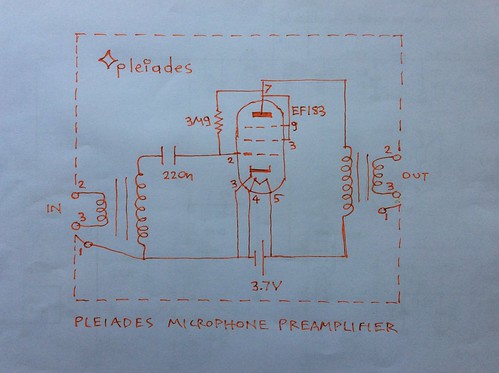Your own risk. Even a battery voltage can be dangerous. A fuse should always be used in series with a battery for safety. And all other precautions should be strictky followed.
It is a battery powered electron tube front end amplifier and the size can be the size of a small guitar pedal. The battery can be inside too.
It is based on Pleiadss V6 or Pleiades V4.

With the following simplifications...
If a low voltage heater electron tube is used then the battery can be just one AA 1.2V supping both heaters and anode. The Pleiades bias grid resistor from anode to grid can be 1.8MΩ.
Suitable electron tubes can be the electrometer CV2269 or Nuvistor 2DS4, 2CW4, 2DV4. Also 4BC8 which may be underheated with a good effect with 1.2V but possibky this would be too extreme. So 2xAA batteries. In this case the anode voltage can be 2.6V which should be plenty. If not then 6.3V heater electron tubes can be used with 3 AA or AAA batteries, such as EF183, Nuvistor 7586 etc. Underheating can produce a very impressive signal,to noise ratio. See previous posts and the Neumann U47 schematic with the VF14 electron tube deliberately underheated by Georg Neumann.
Now why spending time drilling holes and mounting input or output transformers where they can be external?
Impedance converters with a transformer inside an XLR to 1/4in jack adapter can be used and are easy to find. And one can play with various types and primary inductance for the right hiss pass needed for a specific application. See all 3 generation Pleiades filters and transformers.
So all needed:
A top quality battery holder such as Bulgin. The amplifier is sensitive and revealing so the contacts must be top quality to avoid noise.
2 female 1/4in chassis sockets, eg Neutrik.
A fuse holder.
A switch for the heater voltage.
A Pleiades bias resitor from anode to grid.
A coupling capacitor to grid.
That should be it.
It may be possible to directly connect the amplifier to an electret mic in device. At your own risk, see previous post.
It has hi Z in hi Z out. A load resitor might be needed if the next device or stage does not have one. At your own risk.
All other low Z balanced in or out combinations can be done by plugging in suitable XLR impedance converter adaptors with a signal transformer inside them.
Anode might be connected all the time and the heater circuit connected by a 1/4in female chassis socket with switch when a 1/4in jack is plugged in.
Rag may be variable for best sound. A heater series resistor may also turn out to be very interesting sound wise or noise wise.
See also:
http://euroelectron.blogspot.com/2018/07/connecting-electron-tube-instead-of.html
Further reading: The Pleiades Bias - euroelectron
No comments:
Post a Comment